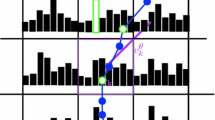Abstract
This work presents a novel object tracking approach, where the motion model is learned from sets of frame-wise detections with unknown associations. We employ a higher-order Markov model on position space instead of a first-order Markov model on a high-dimensional state-space of object dynamics. Compared to the latter, our approach allows the use of marginal rather than joint distributions, which results in a significant reduction of computation complexity. Densities are represented using a grid-based approach, where the rectangular windows are replaced with estimated smooth Parzen windows sampled at the grid points. This method performs as accurately as particle filter methods with the additional advantage that the prediction and update steps can be learned from empirical data. Our method is compared against standard techniques on image sequences obtained from an RC car following scenario. We show that our approach performs best in most of the sequences. Other potential applications are surveillance from cheap or uncalibrated cameras and image sequence analysis.
The research leading to these results has received funding from the European Community’s 7th Framework Programme (FP7/2007-2013) under grant agreement n° 215078 DIPLECS.
Preview
Unable to display preview. Download preview PDF.
Similar content being viewed by others
References
Felsberg, M., Larsson, F.: Learning Bayesian tracking for motion estimation. In: International Workshop on Machine Learning for Vision-based Motion Analysis (2008)
Arulampalam, M.S., Maskell, S., Gordon, N., Clapp, T.: A tutorial on particle filters for online nonlinear/non-Gaussian Bayesian tracking. IEEE Trans. Sig. P. 50, 174–188 (2002)
Isard, M., Blake, A.: CONDENSATION – conditional density propagation for visual tracking. International Journal of Computer Vision 29, 5–28 (1998)
Coué, C., Fraichard, T., Bessière, P., Mazer, E.: Using Bayesian programming for multi-sensor multitarget tracking in automotive applications. In: ICRA (2003)
Granlund, G.H.: An Associative Perception-Action Structure Using a Localized Space Variant Information Representation. In: Proceedings of the AFPAC Workshop (2000)
Johansson, B., et al.: The application of an oblique-projected landweber method to a model of supervised learning. Mathematical and Computer Modelling 43, 892–909 (2006)
Jonsson, E., Felsberg, M.: Correspondence-free associative learning. In: ICPR (2006)
Felsberg, M., Forssén, P.E., Scharr, H.: Channel smoothing: Efficient robust smoothing of low-level signal features. PAMI 28, 209–222 (2006)
Georgiev, A.A.: Nonparamtetric system identification by kernel methods. IEEE Trans. on Automatic Control 29 (1984)
Han, B., Joo, S.W., Davis, L.S.: Probabilistic fusion tracking using mixture kernel-based Bayesian filtering. In: IEEE Int. Conf. on Computer Vision (2007)
North, B., Blake, A.: Learning dynamical models using expectation-maximisation. In: ICCV 1998 (1998)
Ardö, H., Åström, K., Berthilsson, R.: Real time viterbi optimization of hidden markov models for multi target tracking. In: Proceedings of the WMVC (2007)
Streit, R.L., Luginbuhl, T.E.: Probabilistic multi-hypothesis tracking. Technical report, 10, NUWC-NPT (1995)
Shalom, B.Y., Tse, E.: Tracking in a cluttered environment with probabilistic data association. Automatica 11, 451–460 (1975)
Stauffer, C., Grimson, W.E.L.: Learning patterns of activity using real-time tracking. IEEE Trans. Pattern Analysis and Machine Intell. 22, 747–757 (2000)
Jonker, R., Volgenant, A.: A shortest augmenting path algorithm for dense and sparse linear assignment problems. Computing 38, 325–340 (1987)
Snippe, H.P., Koenderink, J.J.: Discrimination thresholds for channel-coded systems. Biological Cybernetics 66, 543–551 (1992)
Pampalk, E., Rauber, A., Merkl, D.: Using Smoothed Data Histograms for Cluster Visualization in Self-Organizing Maps. In: Dorronsoro, J.R. (ed.) ICANN 2002. LNCS, vol. 2415, pp. 871–876. Springer, Heidelberg (2002)
Forssén, P.E.: Low and Medium Level Vision using Channel Representations. PhD thesis, Linköping University, Sweden (2004)
Felsberg, M.: Spatio-featural scale-space. In: Tai, X.-C., et al. (eds.) SSVM 2009. LNCS, vol. 5567, pp. 235–246. Springer, Heidelberg (2009)
Yakowitz, S.J.: Nonparametric density estimation, prediction, and regression for markov sequences. Journal of the American Statistical Association 80 (1985)
Baum, L.E., et al.: A maximization technique occuring in the statistical analysis of probabilistic functions of Markov chains. Ann. Math. Stat. 41, 164–171 (1970)
Rao, R.P.N.: An optimal estimation approach to visual perception and learning. Vision Research 39, 1963–1989 (1999)
Therrien, C.W.: Decision, estimation, and classification: an introduction into pattern recognition and related topics. John Wiley & Sons, Inc., Chichester (1989)
Sochman, J., Matas, J.: Waldboost - learning for time constrained sequential detection. In: Proc. Conf. Computer Vision and Pattern Recognition, vol. 2, pp. 150–157 (2005)
Author information
Authors and Affiliations
Editor information
Editors and Affiliations
Rights and permissions
Copyright information
© 2009 Springer-Verlag Berlin Heidelberg
About this paper
Cite this paper
Felsberg, M., Larsson, F. (2009). Learning Higher-Order Markov Models for Object Tracking in Image Sequences. In: Bebis, G., et al. Advances in Visual Computing. ISVC 2009. Lecture Notes in Computer Science, vol 5876. Springer, Berlin, Heidelberg. https://doi.org/10.1007/978-3-642-10520-3_17
Download citation
DOI: https://doi.org/10.1007/978-3-642-10520-3_17
Publisher Name: Springer, Berlin, Heidelberg
Print ISBN: 978-3-642-10519-7
Online ISBN: 978-3-642-10520-3
eBook Packages: Computer ScienceComputer Science (R0)




